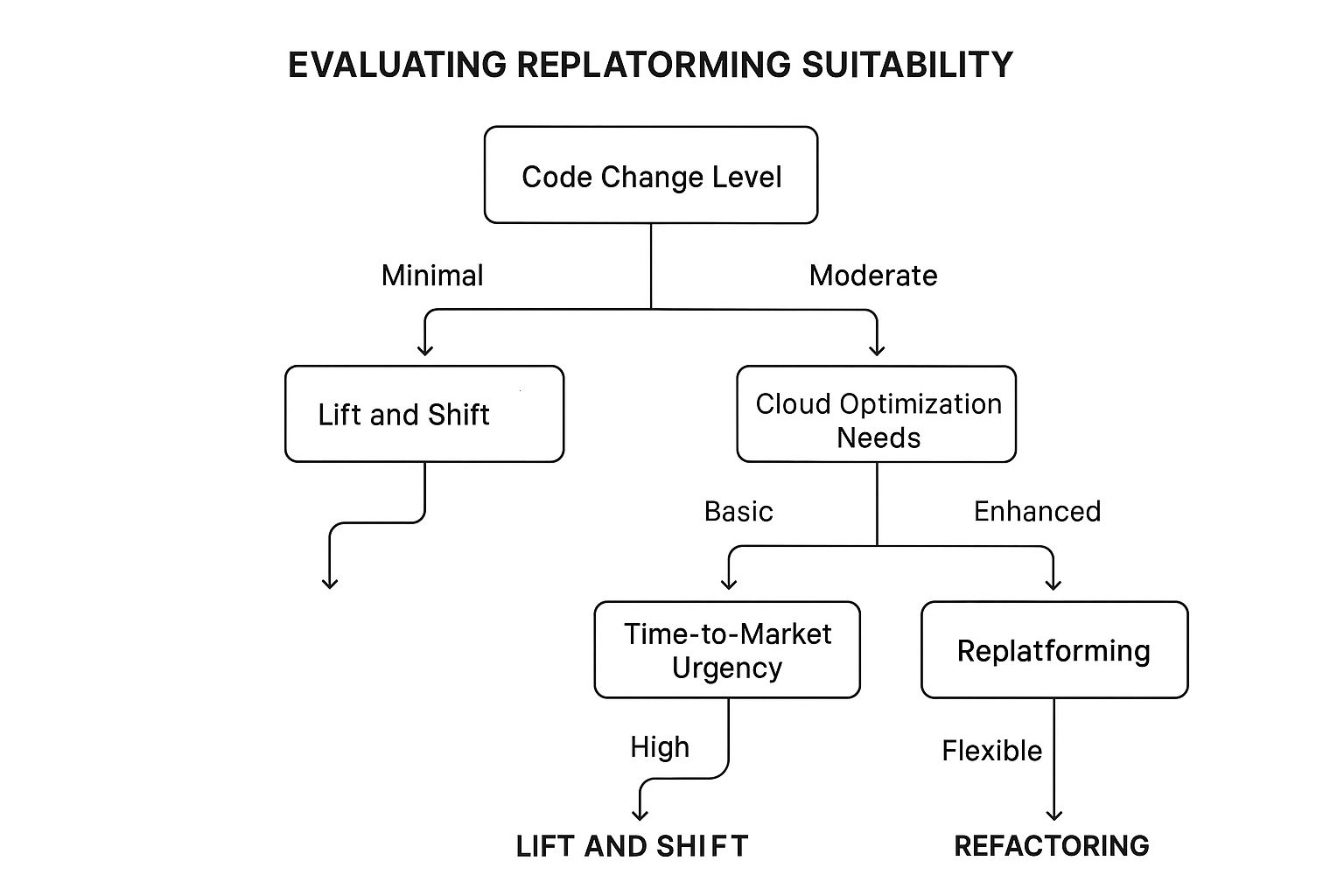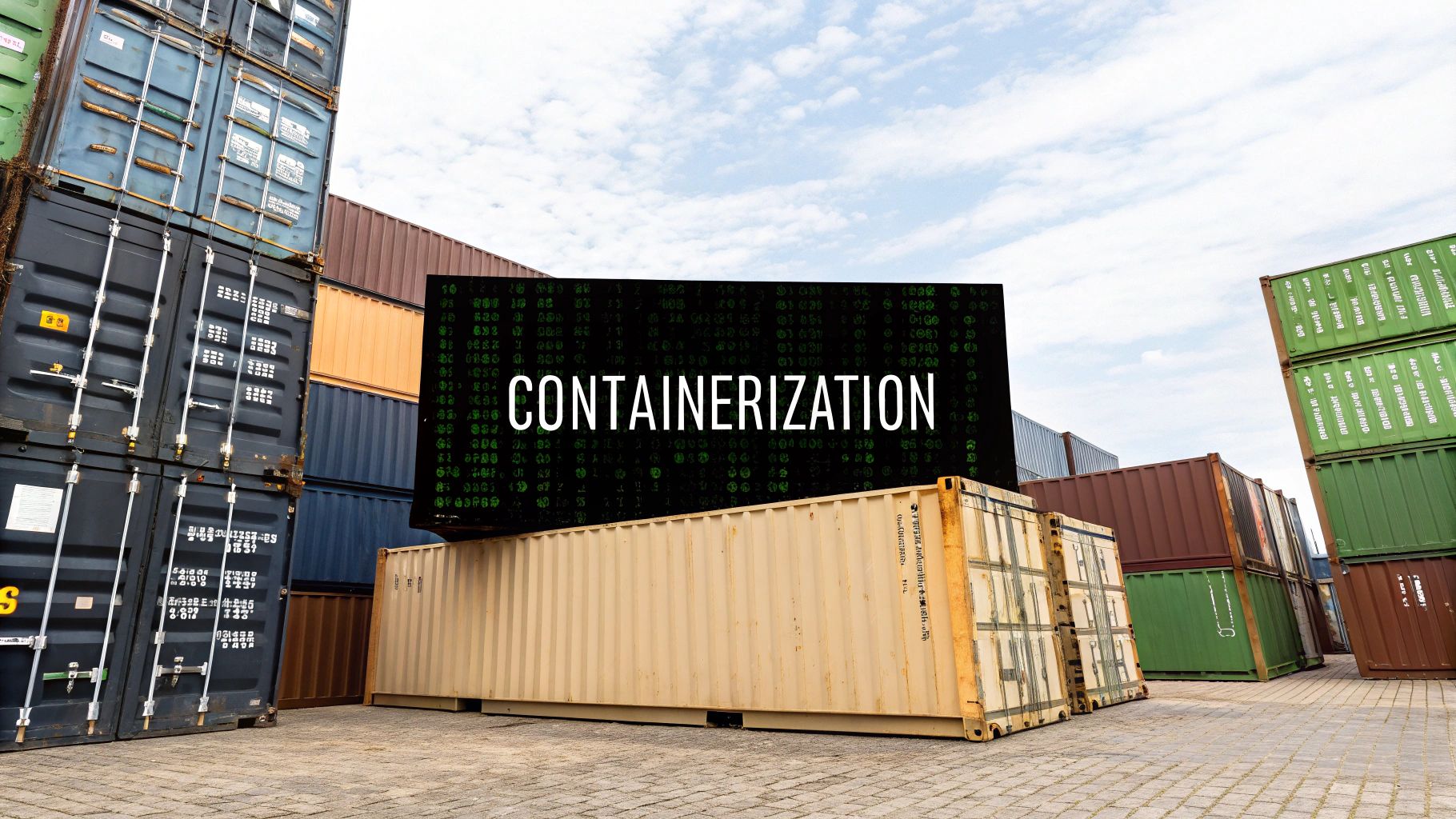In the current competitive market, clinging to outdated legacy applications is a significant business liability. While these systems may have been effective in the past, they often become bottlenecks, hindering innovation, increasing operational costs, and creating substantial security vulnerabilities. The solution isn’t to simply discard decades of business logic, but to strategically evolve it for the modern cloud era. This is precisely the role of application modernization: the process of updating older software to align with contemporary computing approaches, such as newer languages, frameworks, and cloud-native infrastructure.
This guide moves beyond generic advice to deliver a curated roundup of eight powerful and practical application modernization strategies. We will explore actionable insights, real-world scenarios, and a clear implementation path for each distinct approach. You will learn not just the “what” but the “how” and “why” behind each strategy, from a straightforward lift-and-shift to a complete serverless re-architecture. Understanding these options is critical for making informed decisions that balance your business objectives, budget, and technical resources. This knowledge will empower your organisation to unlock new levels of agility, performance, and long-term value from your core software assets.
1. Lift and Shift (Rehosting)
Among the various application modernization strategies, Lift and Shift, also known as rehosting, is often the fastest path to the cloud. This approach involves moving an application from an on-premises data centre to a cloud infrastructure with minimal or no changes to its underlying code or architecture. Essentially, you are taking the application as-is and running it on a new, more scalable platform like AWS, Azure, or Google Cloud.

The primary driver for this strategy is speed and cost reduction. Organisations facing urgent needs like a data centre lease expiry or a desire to rapidly reduce operational overhead often turn to rehosting. By moving to an Infrastructure-as-a-Service (IaaS) model, they can immediately benefit from the cloud’s pay-as-you-go pricing and operational efficiencies without a significant upfront investment in refactoring. For example, General Electric famously migrated over 9,000 applications to AWS, many using a lift-and-shift approach to exit its data centres quickly.
When to Use Lift and Shift
This strategy is ideal for legacy applications where the source code isn’t available or the development team lacks the expertise for a complex rewrite. It’s also a pragmatic first step in a larger, phased modernisation journey, allowing teams to gain cloud experience with lower-risk applications before tackling more complex refactoring projects.
Key Insight: Lift and Shift is not the end of the modernisation journey; it is the beginning. It moves the problem to a better environment where it can be addressed more effectively over time.
Actionable Tips for Implementation
- Conduct Thorough Dependency Mapping: Before migrating, identify and map all application dependencies, including databases, network connections, and third-party services.
- Start with Non-Critical Applications: Begin with less critical workloads to build a repeatable process and gain experience without risking core business operations.
- Utilise Automation: Employ tools like AWS Migration Hub or Azure Migrate to automate the discovery and migration process, reducing manual errors and accelerating the timeline.
- Plan for Post-Migration Optimisation: Once in the cloud, plan to optimise for cost, performance, and security. This could involve right-sizing instances or introducing auto-scaling.
2. Refactoring (Re-architecting)
As one of the more intensive application modernization strategies, Refactoring, also known as re-architecting, involves significantly altering an application’s codebase and architecture. The goal is to leverage cloud-native features like microservices, serverless functions, and containers to improve performance, scalability, and maintainability, all while preserving the core business logic. This is not a simple lift and shift; it is a fundamental transformation.

The primary driver for refactoring is long-term strategic value. Organisations choose this path to unlock agility, accelerate feature development, and reduce technical debt. For instance, Netflix’s famous transition from a monolithic architecture to a distributed microservices platform is a prime example. This re-architecture enabled them to innovate rapidly and scale globally to meet massive user demand, a feat their original monolith could not support.
When to Use Refactoring
This strategy is best suited for core business applications that are strategically important but are constrained by their legacy architecture. If an application requires high scalability, greater resilience, or a faster pace of feature deployment, refactoring is the optimal choice. It allows the organisation to fully harness the power of a Platform-as-a-Service (PaaS) model and modern DevOps practices.
Key Insight: Refactoring is a strategic investment in an application’s future, trading short-term effort for long-term agility and a competitive advantage in the market.
Actionable Tips for Implementation
- Implement the Strangler Fig Pattern: Gradually replace parts of the old system with new services, redirecting traffic piece by piece. This minimises risk compared to a “big bang” rewrite.
- Invest Heavily in Automated Testing: Robust automated testing and a solid CI/CD pipeline are non-negotiable to ensure new components integrate correctly and don’t introduce regressions.
- Start with Problematic Components: Begin by refactoring the modules that are the biggest bottlenecks or the most critical to your business goals to deliver value quickly.
- Ensure Team Skill Development: Equip your development teams with the necessary skills in cloud-native technologies, microservices design, and containerisation platforms like Kubernetes.
3. Replatforming (Lift-Tinker-Shift)
Replatforming, often described as Lift-Tinker-Shift, strikes a strategic balance between the speed of rehosting and the deep changes of refactoring. This approach involves migrating an application to the cloud while making targeted, modest optimisations to leverage cloud-native features. The core architecture remains largely intact, but specific components are upgraded to improve performance, scalability, or operational efficiency on the new platform.
This strategy is one of the most popular application modernisation strategies because it delivers tangible benefits without the high cost and risk of a full rewrite. For instance, Coca-Cola migrated its SAP systems to AWS, not just moving them as-is but also optimising the platform to improve disaster recovery and operational performance. This “tinkering” allowed them to gain immediate cloud advantages beyond simple infrastructure savings.
The following decision tree visualises how to choose between rehosting, replatforming, and refactoring based on key project drivers.

This flowchart highlights that replatforming is the ideal strategy when you need enhanced cloud optimisation and have a flexible timeline, but only require moderate code changes.
When to Use Replatforming
Replatforming is the perfect middle ground when a simple lift-and-shift won’t unlock meaningful cloud benefits, but a complete refactor is impractical due to budget, time, or complexity constraints. It’s ideal for applications where you can achieve significant gains by making small changes, such as swapping a self-managed database for a managed cloud service like Amazon RDS or Azure SQL Database, or implementing auto-scaling.
Key Insight: Replatforming allows organisations to harvest low-hanging fruit. It modernises applications incrementally, delivering measurable value quickly while paving the way for future, more extensive transformations.
Actionable Tips for Implementation
- Identify High-Impact Optimisations: Analyse the application to find low-risk, high-reward changes. Focus on swapping out components for platform-native services (e.g., messaging queues, databases, storage).
- Prioritise Platform-Native Services: Leverage managed services for databases, caching, and logging. This reduces operational burden and often improves performance and reliability.
- Implement Cloud Monitoring: Integrate cloud-native monitoring and logging tools like Amazon CloudWatch or Azure Monitor from the start to gain visibility into the application’s performance and health.
- Optimise for Elasticity: Configure auto-scaling and load balancing to ensure the application can handle variable traffic efficiently, paying only for the resources you consume.
4. Containerization Strategy
As one of the most transformative application modernization strategies, Containerization involves packaging an application and all its dependencies into a single, lightweight, and portable unit called a container. Popularised by technologies like Docker, this approach ensures that the application runs consistently across different computing environments, from a developer’s laptop to an on-premises data centre or the public cloud.

The core benefit of containerization is its efficiency and portability. Unlike virtual machines that virtualise an entire operating system, containers virtualise the operating system itself, allowing multiple containers to run on a single OS kernel. This leads to significantly better resource utilisation, faster start-up times, and simplified deployment pipelines. For instance, Spotify successfully containerised its entire platform using Docker and the Kubernetes orchestration engine to manage thousands of microservices, boosting developer productivity and platform resilience.
When to Use Containerization
This strategy is ideal for organisations aiming to improve scalability, streamline their CI/CD processes, and adopt a microservices architecture. It’s particularly effective for applications that need to be deployed across hybrid or multi-cloud environments, as containers abstract away the underlying infrastructure. It also serves as a powerful stepping stone towards a fully cloud-native ecosystem without requiring an immediate, complete rewrite of the application logic.
Key Insight: Containerization decouples the application from the environment. This separation is crucial for building portable, scalable, and resilient systems fit for the modern cloud era.
Actionable Tips for Implementation
- Start with Stateless Applications: Begin your containerization journey with stateless applications, as they are simpler to manage and scale without complex data persistence requirements.
- Implement Robust Security Scanning: Integrate container security scanning tools into your CI/CD pipeline to detect vulnerabilities in images before they reach production.
- Leverage Container Registries: Use a private container registry like Docker Hub, AWS ECR, or Azure Container Registry for secure storage, versioning, and management of your container images.
- Invest in Orchestration and Observability: Employ a container orchestrator like Kubernetes to automate deployment, scaling, and management. Complement this with robust monitoring and observability tools to gain insight into container performance. Learn more about choosing the right orchestration service in our EKS vs. ECS comparison on signiance.com.
5. API-First Modernisation
In the realm of application modernization strategies, an API-First approach decouples the front-end user experience from the back-end logic. This strategy prioritises creating a layer of well-designed, secure, and documented Application Programming Interfaces (APIs) that expose the core functionalities of existing systems. Instead of overhauling the entire legacy application at once, you build modern interfaces that new applications can consume, effectively insulating them from the complexity of the underlying monolith.
This method allows organisations to innovate faster by enabling new mobile, web, and partner integrations to connect to legacy data and processes securely. It transforms monolithic systems into modular, service-oriented platforms without immediate, high-risk refactoring. For example, Stripe built its entire business model on powerful, easy-to-use payment APIs, allowing countless businesses to integrate complex payment processing with just a few lines of code, bypassing legacy banking systems. Similarly, Twilio used an API-first strategy to make complex telecommunication services accessible to developers.
When to Use API-First Modernisation
This strategy is highly effective when you need to quickly enable new digital channels or integrate with third-party services while the core legacy system remains functional but difficult to modify. It’s also ideal for organisations aiming to build a platform ecosystem, allowing partners and external developers to build on top of your core services. This approach facilitates a gradual, less disruptive path to modernising the back end over time.
Key Insight: API-First Modernisation turns your legacy systems from a liability into an asset by unlocking their valuable data and functionality for modern use cases, creating new business opportunities.
Actionable Tips for Implementation
- Design with Standards: Adopt a clear API design standard like REST or GraphQL and maintain consistency. Use tools like OpenAPI Specification (formerly Swagger) for clear, machine-readable documentation.
- Prioritise Security: Implement robust security measures from the start. Use an API gateway to manage authentication (e.g., OAuth 2.0), authorisation, and rate limiting to prevent abuse.
- Plan for the Lifecycle: Establish a clear strategy for API versioning and a deprecation policy. This ensures that you can evolve your APIs without breaking existing consumer applications.
- Focus on Developer Experience: Provide comprehensive documentation, software development kits (SDKs), and sandbox environments to make it easy for developers to discover, understand, and use your APIs.
6. Database Modernisation
Often, the biggest barrier to application performance and scalability lies not in the application code itself, but in its underlying database. Database Modernisation is a focused strategy that updates the database system and its associated data management practices. This approach swaps legacy, monolithic databases for modern, cloud-native services to resolve data-related bottlenecks and unlock advanced capabilities, often without a complete application rewrite.
This modernisation strategy involves migrating data from outdated systems like on-premises Oracle or MySQL to flexible, scalable, and managed cloud databases such as Amazon Aurora, Google Cloud SQL, or Azure Cosmos DB. The goal is to improve performance, scalability, and resilience while reducing the administrative overhead of managing database infrastructure. For example, Capital One famously migrated its core banking systems from Oracle to cloud-native databases like Amazon Aurora and DynamoDB, significantly improving its agility and data processing capabilities.
When to Use Database Modernisation
This strategy is perfect when the core application logic is sound, but the database is causing performance issues, high licensing costs, or operational complexity. It is an effective approach for applications that need to handle variable traffic, require higher availability, or want to leverage modern data analytics and machine learning services that integrate seamlessly with cloud databases.
Key Insight: Modernising the database can be a high-impact, targeted initiative that delivers significant application improvements without the risk and cost of a full rewrite. It directly addresses the data gravity problem.
Actionable Tips for Implementation
- Conduct a Thorough Data Assessment: Before migrating, map out your data models, schemas, dependencies, and access patterns to understand the full scope.
- Test Rigorously in Non-Production: Set up a parallel environment to perform extensive migration and performance testing. This helps identify issues with queries, indexes, and application compatibility before going live.
- Utilise Database Migration Tools: Leverage native services like AWS Database Migration Service (DMS) or Azure Database Migration Service to automate and simplify the transition.
- Plan for Data Synchronisation: For migrations with minimal downtime, implement a strategy for continuous data replication to keep the old and new databases in sync during the transition period.
- Optimise for the New Platform: After migrating, focus on database performance tuning by rewriting critical queries and rebuilding indexes to take full advantage of the new platform’s features.
7. Serverless Architecture Migration
A paradigm shift in cloud computing, Serverless Architecture Migration is one of the more advanced application modernization strategies. It involves restructuring an application to run on a serverless platform, where the cloud provider dynamically manages the allocation and provisioning of servers. Your code runs in stateless, event-driven compute containers, freeing your team from server management entirely.
This approach, popularised by services like AWS Lambda, Azure Functions, and Google Cloud Functions, means you only pay for the exact compute time consumed. The architecture automatically scales from zero to thousands of requests in seconds without any manual intervention. For instance, Coca-Cola built its touchless fountain dispenser platform using serverless functions on AWS, enabling rapid, cost-effective scaling to meet unpredictable demand across thousands of machines. Similarly, Thomson Reuters leverages a serverless pipeline for real-time news processing.
When to Use Serverless Architecture Migration
This strategy is exceptionally well-suited for applications with unpredictable traffic patterns, event-driven workloads like image processing or data ingestion, and microservices architectures. It excels for organisations that want to maximise operational efficiency, minimise infrastructure costs, and accelerate development cycles by allowing developers to focus solely on writing business logic instead of managing servers.
Key Insight: Serverless isn’t about having “no servers”; it’s about having “no server management.” This transfers the operational burden of scalability, patching, and maintenance to the cloud provider, enabling immense agility.
Actionable Tips for Implementation
- Start with Stateless Components: Begin your migration with stateless, event-driven parts of your application, such as API endpoints or background processing jobs, as they are a natural fit for the serverless model.
- Design for Brevity: Architect your functions to be small, single-purpose, and fast-starting. This “single responsibility principle” improves performance, simplifies debugging, and enhances maintainability.
- Implement Robust Error Handling: Given the distributed and ephemeral nature of serverless functions, implement comprehensive error handling, logging, and retry mechanisms (like dead-letter queues) to ensure resilience.
- Leverage Serverless Frameworks: Use tools like the Serverless Framework or AWS SAM to streamline the development, deployment, and management of your serverless applications across different cloud providers.
- Monitor Performance and Cost: Actively monitor function execution time, memory usage, and invocation counts using cloud-native tools to optimise performance and keep costs under control.
8. Hybrid Cloud Strategy
A Hybrid Cloud Strategy is one of the most flexible and pragmatic application modernization strategies, blending private cloud infrastructure, on-premises data centres, and public cloud services. This approach allows organisations to strategically place workloads and data where they make the most sense, enabling a gradual, controlled modernization journey without a complete commitment to a single environment. Applications and data can move between these environments based on specific business, security, or performance needs.
This model provides the best of both worlds: the security and control of a private environment combined with the scalability and innovation of the public cloud. For instance, an organisation might keep its sensitive customer database on-premises to meet strict data sovereignty regulations while running its customer-facing web application on a public cloud to handle variable traffic. BMW leverages a hybrid cloud approach for its manufacturing systems, processing critical data on-site while using the cloud for large-scale analytics.
When to Use a Hybrid Cloud Strategy
This strategy is ideal for organisations with significant existing investments in on-premises infrastructure or those in highly regulated industries like finance and healthcare. It allows them to modernise applications incrementally, containerise workloads for portability, and still meet stringent compliance or data residency requirements. It also serves as a bridge for companies that are not yet ready to go “all-in” on the public cloud but want to start leveraging its benefits.
Key Insight: A hybrid cloud strategy isn’t a temporary compromise; it’s a deliberate, long-term approach that gives enterprises the agility to innovate while maintaining control over critical assets and data.
Actionable Tips for Implementation
- Develop Clear Workload Placement Criteria: Define a clear policy for deciding where applications and data should reside based on factors like security, compliance, performance, and cost.
- Implement Consistent Governance: Use a unified management plane to enforce consistent security, governance, and operational policies across all your cloud and on-premises environments.
- Embrace Containerisation: Utilise technologies like Docker and Kubernetes to package applications, ensuring they are portable and can run consistently across different environments. You can learn more about structuring these environments by exploring hybrid cloud architectures.
- Prioritise Network Connectivity: Plan a robust and secure network connection between your on-premises data centre and public cloud providers to ensure low latency and reliable data transfer.
Application Modernization Strategies Comparison
| Strategy | Implementation Complexity | Resource Requirements | Expected Outcomes | Ideal Use Cases | Key Advantages |
|---|---|---|---|---|---|
| Lift and Shift (Rehosting) | Low – minimal code changes | Low – minimal development effort | Moderate – preserves existing functions | Tight timelines, limited budgets, straightforward migration | Fastest migration, low complexity, quick ROI |
| Refactoring (Re-architecting) | High – major redesign and rewriting | High – skilled developers, time | High – cloud-native, scalable, optimized | Applications with technical debt or scalability needs | Full cloud leverage, better performance, maintainability |
| Replatforming (Lift-Tinker-Shift) | Medium – selective optimizations | Moderate – some code and config changes | Moderate to high – improved cloud fit | Moderate improvements with manageable risk | Balanced risk/cost, faster than refactoring |
| Containerization Strategy | Medium to high – requires container expertise | Moderate – container tools & orchestration | High – improved portability, deployment efficiency | Applications needing better deployment flexibility | Resource efficiency, portability, scaling |
| API-First Modernization | Medium – design and expose APIs | Moderate – API management tools | Moderate – enables integration and modernization | Exposing legacy functions, integration platforms | Gradual modernization, improved interoperability |
| Database Modernization | Medium – data migration complexity | Moderate – new DB tech & migration tools | High – better performance, scalability | Database bottlenecks, scalability, admin cost reduction | Improved analytics, cost optimization |
| Serverless Architecture | High – redesign for event-driven | Moderate to high – serverless platforms | High – cost-efficient, autoscaling systems | Variable workloads, event-driven apps, ops minimization | No server management, automatic scaling |
| Hybrid Cloud Strategy | High – multi-environment management | High – complex infrastructure | Moderate to high – workload flexibility | Compliance-heavy orgs, existing infra, varied workloads | Flexibility, compliance, gradual migration |
Choosing Your Path and Partnering for Success
Navigating the complex landscape of application modernization strategies requires more than just technical know-how; it demands a strategic vision aligned with your core business objectives. We have explored a spectrum of powerful approaches, from the swift, tactical benefits of Rehosting (Lift and Shift) to the transformative, long-term value of complete Refactoring. Each strategy, whether it’s Replatforming to a managed service, embracing Containerization for portability, or adopting a Serverless architecture for ultimate scalability, offers a unique set of advantages and trade-offs.
The key takeaway is that the ideal modernisation journey is rarely a single, linear path. A successful initiative often involves a blended approach. You might rehost less critical workloads to quickly exit a data centre, while simultaneously refactoring a core, revenue-generating application to build a sustainable competitive advantage. The choice depends on a thorough analysis of your application portfolio, technical debt, team skills, and market pressures.
Key Considerations for Your Modernisation Roadmap
Before committing to a path, it’s crucial to evaluate your organisation’s unique position. The most effective application modernization strategies are those tailored to specific needs. Consider the following critical factors:
- Business Drivers: What is the primary goal? Is it reducing operational costs, accelerating feature delivery, improving system resilience, or entering new markets? Clearly defining the ‘why’ will guide your ‘how’.
- Technical Feasibility: Assess the current state of your application. Is the architecture monolithic or loosely coupled? Is the codebase well-documented or a black box? A realistic technical assessment will prevent costly missteps.
- Organisational Readiness: Does your team possess the necessary cloud and DevOps skills? Modernisation is as much about evolving your culture and processes as it is about changing your technology stack.
The Power of Partnership in Transformation
Embarking on this journey is a significant undertaking that reshapes your technological foundation and, by extension, your business’s future. The strategies discussed, from API-first design to hybrid cloud integration, are not just isolated projects; they are foundational shifts that unlock new levels of agility, innovation, and efficiency.
Successfully executing these strategies transforms legacy systems from business inhibitors into powerful enablers of growth. This transformation allows you to respond rapidly to market changes, deliver exceptional customer experiences, and secure a lasting competitive edge. However, this journey is intricate and filled with potential pitfalls. Partnering with a specialist who has navigated these challenges can be the difference between a stalled project and a successful digital transformation. Your legacy systems hold immense value, and with the right strategy, you can unlock that potential for the cloud era.
Ready to turn strategy into action? Signiance Technologies specialises in creating and executing bespoke application modernisation roadmaps that align with your business goals. Contact us today to discover how our expert cloud architects and engineers can help you navigate your cloud journey with confidence and technical excellence.
